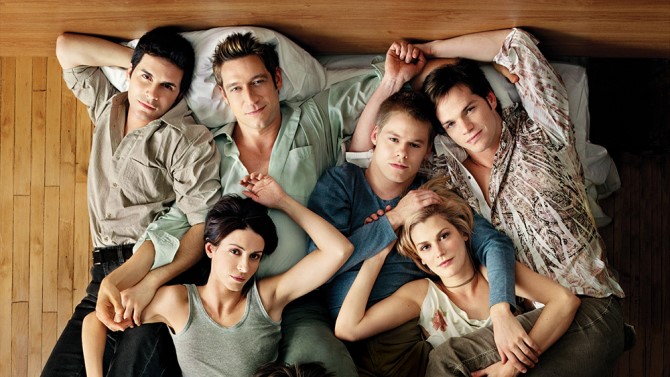In this week blog, I will be considering how “queer” is represented in the media. In the 21st century homosexuality, bisexuality and trans-sexuality is no longer confined to the realm of secrecy. Multiple movies and TV shows includes homosexual characters or have homosexual character in lead roles. More importantly, these characters are shown to have successful careers, find love and build families of their own. LGBT and other equal rights movements have not only raised awareness but have also appealed for the acceptance and tolerance of non-normative sexualities. Television has increasingly become a medium and space where homosexuality is being normalised as well as contested. For instance, sitcoms such as The Modern Family and The New Normal attempt to reinvent the image of a typical queer man. Furthermore, the titles of the shows use adjectives such as modern, new and normal to describe its content. In turn legitimising homosexuality as an ordinarily intrinsic part of contemporary American society.
Modern depictions have moved away from stereotypical characterisation of “gay” men. They are no longer solely feminine men or men mimicking what would be classed as feminine behavioural traits. The American-Canadian TV show, Queer as Folk has made significant contribution to altering popular media depiction of “gay” men. It first began on the 3rd of December 2000 and ended on the 7th of August 2005. The show was based on the British TV series of the same name. More importantly, Queer as Folk was the first hour long drama depicting the lives of homosexual men and women. However, this show was not only ground-breaking for this reason. It attempted to demonstrate that individuals who identified themselves as homosexual or even transsexual could easily be identified as heteosexuals. For instance, the male characters on this show encountered everyday problems, and lived life like any other “normal” individual. If anything was presented as deviating from the norm, it was their choices in sexual partners. Homosexuality is not depicted as strange or fetishised. Instead, queer men are relatable, and given a space to challenge stereotypical popular depictions.

More to the point, in these portrayals whether “negative” or “positive” white homosexuality is accounted for in the media. Therefore, when watching even the most modern sitcoms, I am left with wondering what about black homosexual men? I am mainly referring to men, because I have noticed this problem persistently in representations concerning homosexual men. Whether one examines 20th century depictions or current representation, Queer is still a white thing. White homosexual men are given the opportunity to reclaim their sexuality as normal, and acceptable. The issue of race is unacknowledged in most of these shows. The most important issue being addressed in these sitcoms and drama productions is sexuality, thus forgetting that race and sexuality for many people are interlinked. Author James Baldwin insisted that “race and sex must be approached as immutably interconnected and that homophobia was to be combated alongside racism”[1]. However, media representation of queer hesitate, and in many ways fail to account for black homosexual experiences.
This is why individuals such as Miss Lawrence from The Real Housewives of Atlanta are forced to leave TV shows, due disrespect. In an interview with BET, he explained that some of the women on the show did not respect the gay community, nor understand their situation. The fashion designer conveyed his issues in this manner: “I don’t think they’re homophobic. What I’m saying is, they need to be held accountable for the cultural appropriation and they need to understand how to respect our culture – what’s appropriate to say and what’s not”[2]. Miss Lawrence was both hypervisible and invisible on a show where his race is dominantly represented. In other words, his sexuality turned him into a spectacle, he was both ridiculed and misunderstood.

This pattern of under-representation of black homosexual men is also evident on YouTube. There are numerous videos of people “coming out” (taking ownership of their sexuality), and yet again most of these videos have white protagonists. Their efforts are rightfully applauded and acknowledged. The Rhodes brothers uploaded a video on their channel entitled: Twins Come Out To Dad.
In this video, the twin brothers candidly phone their father, and inform him that they are both homosexuals. Their struggles as white homosexual men are documented and rightfully validated through social media. This video has over 23 million views, and circulation has ensured that their story is watched and re-watched by people all over the world. The circulation of this video also encourages other people to “come out”, and share their experiences. Black homosexual men are not given the opportunity to achieve this through popular culture, as a result, they may not feel comfortable in engaging with discussion of sexuality on social media. They are doubly oppressed, and this remains unacknowledged by mainstream media.
(Note: I am aware that my post has neglected transsexuals and bisexual individuals. However, I have done this deliberately in order to focus on the lack of black homosexual male representation).
[1] James Baldwin’s Turkish Decade: Erotics of Exile, Magdalena Zaborowska.
[2] Link to interview: http://www.musictimes.com/articles/49078/20150924/miss-lawrence-left-rhoa-didnt-respect-gay-culture-token-guy.htm.

